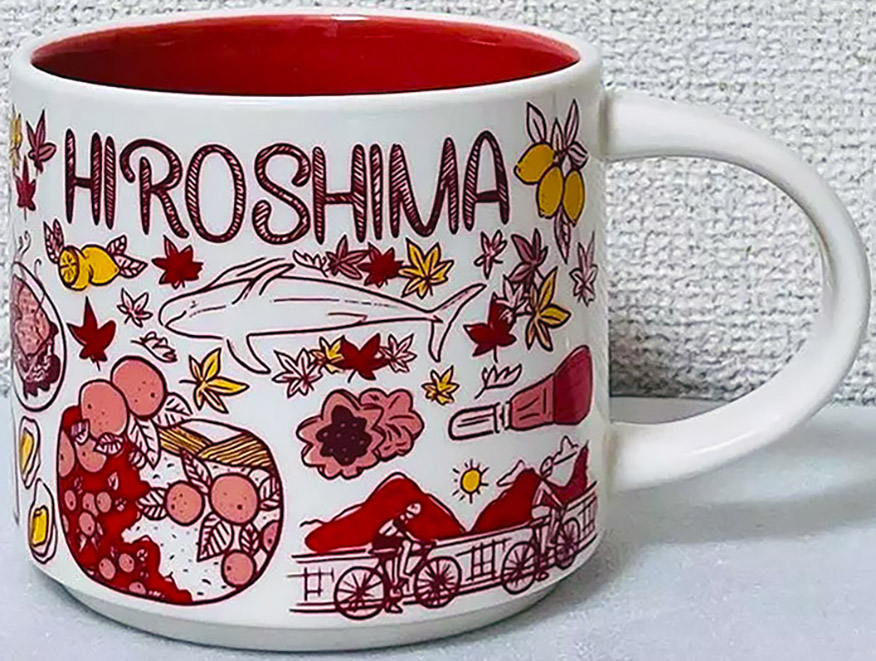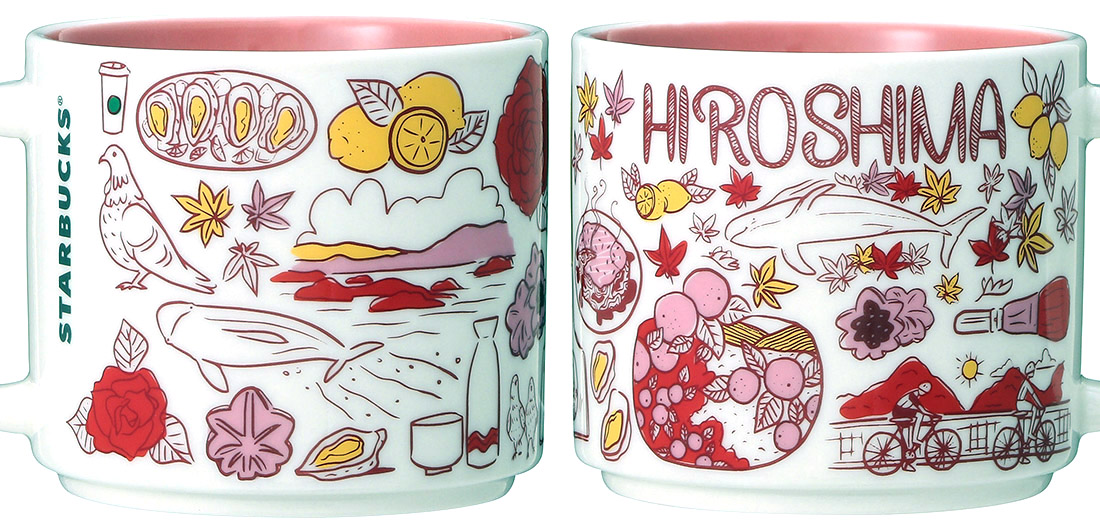
Been There – Hiroshima
Starbucks Been There – Hiroshima is a mug for a city in Japan’s Chūgoku region, which has a rich history that extends far beyond the tragic events of World War II. Founded in the late 16th century by the powerful warlord Mōri Terumoto, Hiroshima developed as a key economic and cultural hub in western Japan. The city thrived through the Edo period and into the modern era, becoming a center for industry and education. However, Hiroshima is most widely recognized internationally for the atomic bombing on August 6, 1945, which resulted in massive destruction and loss of life. Despite this devastating event, the city has shown remarkable resilience. In the post-war period, Hiroshima underwent extensive reconstruction and revitalization, transforming into a beacon of peace and a symbol of recovery. Today, Hiroshima is home to numerous cultural landmarks, including Hiroshima Castle, Shukkei-en Garden, and the Hiroshima Peace Memorial Park, which commemorates the victims of the bombing while promoting a message of global peace and nuclear disarmament.
The design of the Been There Hiroshima mug focuses mostly on vibrant local scenery, it seems:
– The dolphins on the front and the back of the mug, are probably related to Miyajima Public Aquarium. Located on Miyajima Island, near Hiroshima, it offers a fascinating glimpse into the marine life of the Seto Inland Sea and beyond. Opened in 2002, the aquarium features a diverse array of exhibits showcasing various aquatic species, including colorful tropical fish, majestic sea turtles, and playful sea lions. One of the highlights is the large main tank, which replicates the region’s natural habitat, allowing visitors to observe the interactions of marine life in a dynamic environment. The aquarium also emphasizes conservation and education, offering informative displays and interactive experiences that raise awareness about the importance of marine ecosystems. Surrounded by the scenic beauty of Miyajima, the aquarium provides a delightful outing for families and nature enthusiasts alike, making it a must-visit attraction on the island.
– Mikan, or Japanese mandarins, are one of Hiroshima’s most beloved fruits, celebrated for their sweet and juicy flavor. Grown in the region’s temperate climate, these citrus fruits are particularly popular during the winter months when they are harvested. Their easy-to-peel skin and refreshing taste make them a favorite snack among locals and visitors alike. Mikan orchards are a common sight in Hiroshima, and the fruit is often enjoyed fresh, used in desserts, or featured in various traditional dishes, embodying the essence of seasonal Japanese cuisine.
– Persimmons, known as “kaki” in Japanese, thrive in Hiroshima’s fertile soil and favorable climate, resulting in some of the finest specimens in the country. These orange fruits are typically harvested in the fall and are prized for their sweet, honey-like flavor and unique texture. Hiroshima’s persimmons are enjoyed both fresh and dried, with the dried version being a popular treat, especially during the colder months. The region’s rich agricultural tradition has made persimmons not only a delicious snack but also an important part of local culture and seasonal celebrations.
– Hiroshima is renowned for its luscious peaches, which are celebrated for their exceptional sweetness and fragrant aroma. The region’s warm climate and rich soil contribute to the production of some of Japan’s most sought-after varieties. Harvested in the summer, these peaches are typically enjoyed fresh, making them a popular choice at local markets and festivals. Known for their juicy flesh and delicate flavor, Hiroshima peaches are often given as gifts and are a cherished symbol of summer in the
region, embodying the beauty of Japan’s seasonal bounty.
– Hiroshima Botanical Garden is a beautifully landscaped area that showcases a diverse collection of plants and flowers, including an impressive rose garden. Spanning approximately 150 acres, the garden features various themed sections, such as Japanese, tropical, and alpine gardens, providing visitors with a tranquil escape into nature.
– Hiroshima is famous for its high-quality oysters, particularly those harvested from the nearby waters of the Seto Inland Sea. Hiroshima oysters are celebrated for their rich flavor and firm texture, making them a favorite in various dishes. The region’s unique tidal conditions and nutrient-rich waters contribute to the oysters’ exceptional taste, leading to a thriving aquaculture industry. During the winter months, oyster festivals are held, attracting locals and tourists alike to enjoy fresh oysters prepared in a variety of ways, from grilled to raw, highlighting Hiroshima’s culinary heritage.
– Okonomiyaki is a popular savory Japanese pancake, often referred to as “Japanese pizza” due to its hearty toppings. The name translates to “grilled as you like it,” reflecting the customizable nature of the dish. The base typically consists of a batter made from flour, eggs, shredded cabbage, and dashi (broth), which is then cooked on a griddle. Various ingredients, such as meat, seafood, and cheese, can be added according to personal preference. Once cooked, okonomiyaki is often topped with a tangy sauce, mayonnaise, seaweed flakes, and bonito flakes, creating a delicious and satisfying meal that is especially popular in Hiroshima and Osaka.
While not displayed in the design, here are some notable places to visit in Hiroshima that remind us of the tragic history of the city:
The Hiroshima Peace Memorial Park serves as a central location for remembrance, featuring monuments, memorials, and the iconic Atomic Bomb Dome, a UNESCO World Heritage Site that stands as a haunting reminder of the devastation. The Hiroshima Peace Memorial Museum complements the park with exhibits detailing the history of the bombing, the experiences of survivors, and the importance of promoting peace and nuclear disarmament.























































































